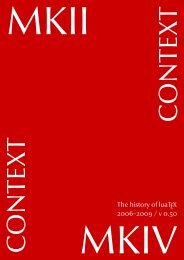font manual - Pragma ADE
font manual - Pragma ADE
font manual - Pragma ADE
You also want an ePaper? Increase the reach of your titles
YUMPU automatically turns print PDFs into web optimized ePapers that Google loves.
2<br />
• typeface definitions: they package serif, sans serif, mono spaced and math and<br />
other styles in such a way that you can conveniently switch between different combinations<br />
These three mechanisms are actually build on top of each other and all rely on a low<br />
level mapping mechanism that is responsible for resolving the real <strong>font</strong> file name and<br />
the specific <strong>font</strong> encoding used.<br />
When T E X users install one of the T E X distributions, like T E X-live, they will have a lot<br />
of <strong>font</strong>s already on the system. Unfortunately it is not that easy to get a clear picture<br />
of what is there and what is needed to use them. Although the texmf tree is prepared<br />
for commercial <strong>font</strong>s, adding them is not trivial. To compensate this, ConT E Xt comes<br />
with tex<strong>font</strong>.pl, that can install <strong>font</strong>s for you. Also, to help you on your way, we<br />
provide typescripts for a couple of free <strong>font</strong>s.<br />
2 Font files and encodings<br />
In ConT E Xt when possible you should use symbolic names for <strong>font</strong>s. The mapping<br />
from these names onto real ones in most cases goes unnoticed for the user. This is<br />
good since the name depends on the encoding and therefore not seldom is obscure<br />
and hard to remember.<br />
\define<strong>font</strong>synonym [Serif]<br />
[Palatino]<br />
\define<strong>font</strong>synonym [Palatino] [uplr8t]<br />
[encoding=ec]<br />
The advantage of using for instance Serif in definitions is, that we can later easily<br />
remap this name onto another <strong>font</strong> than Palatino. In a similar way, we can define<br />
new names that map onto Serif.<br />
\define<strong>font</strong>synonym [TitleFont] [Serif]<br />
By using symbolic names in for instance style and macro definitions, you can make<br />
them independent of a particular <strong>font</strong> and let themselves adapt to the main document<br />
<strong>font</strong>s, which normally are defined in terms of Serif.<br />
There is no limitation on the level of mapping, but the last one in the chain has to be a<br />
valid <strong>font</strong> filename. Specific <strong>font</strong> encoding declarations take place at that level, since<br />
they are closely related to specific instances of <strong>font</strong>s. We come back to this in later<br />
sections.
















